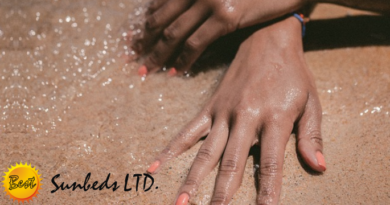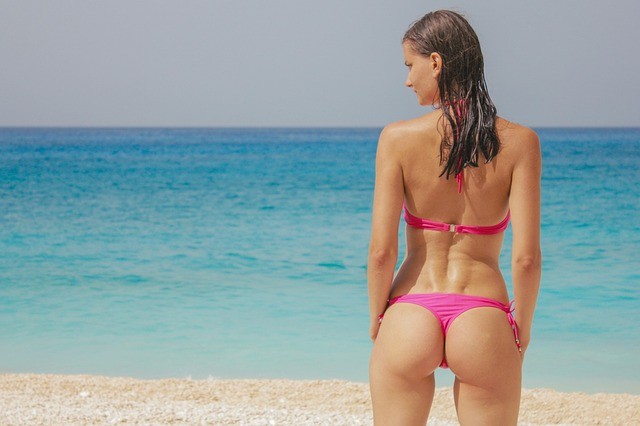The Tanning Process – How our skin tans
So we know that using sunbeds with quality cosmetics gives you a beautiful bronzed glow, but what is the science behind it? Here we will delve deep into the skin, and explain the tanning process!
UV light spectrum
- UVA – This penetrates deeper into the skin and is the component of the ultra violet spectra most responsible for the natural tanning process.
- UVB – Has a higher radioactive content than UVA waves, and primarily affects the outer layers of the skin. Sunburn comes about from overexposure to this. Compared to natural ultraviolet light from the sun; sunbeds emit a lower amount of UVB radiation allowing for less chance of burning. That is not to say it’s not possible – Sunbeds emit 2-5 times more UVA than the sun, and prolonged exposure will cause burning.
- UVC – This is the strongest component of the spectrum and therefore the most dangerous. The Earth’s atmosphere shields us from natural exposure, however a small amount does get through. Tanning beds do not provide any exposure to UVC.
On average, a sunbed tube emits around 2% UVB, the rest being UVA, although there are many different variations available. There is no UVC emitted by sunbed tubes.
The tanning process
The outer layer of the skin (epidermis) is where the tanning process occurs. UVB light stimulates special cells in the epidermis, called melanocytes to produce a pigment called melanin. This pigment moves through the epidermis whilst at the same time being absorbed by surrounding skin cells. UVA acts upon the melanin near the surface by oxidising it. This turns the melanin brown and creates what we know as a tan. Not instantaneous, melanin production takes time. A number of short sessions are needed as a result.
Everyone has the same number of melanocytes, but genetics and heredity are what determines exactly how much pigment will be produced. Two pigments are actually produced: The brown eumelanin and the yellow/red pheomelanin, which is why they find it difficult to tan. Interestingly people who suffer from albinism are not able to produce melanin because they do not have the amino acid tyrosine present.
Nothing lasts forever and this holds true for skin. Our skin sheds itself daily and every month a new epidermis has completely generated. Although as we lose skin cells so we lose what tan we have. A tan has to be maintained, and if lost, completely built up again from scratch.
The benefits of the tanning process
We know that having a tan produces the euphoric “Look good, feel good” sensation. Yet few people realise that UV light can be directly linked to the feel good aspect. The science behind this is called heliotherapy. Experts have defined this science as the healing and treatment of disorders and diseases by simple exposure to the ultra violet component of sunlight (provided the exposure is regulated and controlled)
The body needs a whole range of vitamins to function optimally. Vitamin D is no exception. Exposure to the UVB portion of the UV spectrum causes your skin to produce this “Sunshine” vitamin.
Vitamin D benefits:
- Prevention of osteoporosis, and encouraging the maintenance of healthy bones and teeth. This is because it facilitates the body’s ability to absorb calcium
- Prevention of breast, colon and prostate cancers.
- Treating high cholesterol. Production of vitamin D has been found to increase the body’s capacity to metabolise cholesterol.
- Treating high Blood Pressure
- Providing a boost to the immune system and improving circulation.
- Preventing seasonal affective disorder (SAD), PMS and rheumatoid arthritis.
- Treating skin disorders such as acne, psoriasis, and eczema.
Benefits of using a sunbed
It’s a controlled way to tan – i.e. avoiding burning.
Unfortunately, there are a number of misconceptions about sunbeds and sunbed use, much of which is the result of misinformation in the media. This means that a lot of people are unsure about whether it is safe to use a sunbed or sunbathe.
The most common misconception is “Can I get skin cancer from just using a sunbed?”
All the medical and scientific evidence points to over-exposure or burning as the factor which increases your risk of developing skin cancer. Particularly if the burning happens in childhood. Using a sunbed responsibly is a controlled way to obtain your tan through UV exposure.
Plus, very importantly, it can help maintain your vitamin D levels.
Can everyone use a sunbed?
No.
The following is a list of people and contraindications to sunbed use:
- Under 18’s
- Pregnant women
- Skin type 1 (see further below)
- Skin cancer or a history of skin cancer in the family.
- Heart Conditions
- High/low blood pressure
- Epilepsy
- Diabetes
- Organ transplants and excessive moles
- Recent operations
- Certain medications that cause photo-sensitivity
A comprehensive list can be found on your UV disclaimer cards. Everyone must fill in one of the disclaimer cards whether they are family, staff, friends or members. This is your safety net, so when health and safety pay a visit, you have all the correct records. These cards MUST be kept.
Should anybody tick any contra-indication they should not use the sunbed. With regard to issues such as medication, if unsure, only allow the customer use of the equipment with a doctors/pharmacy note.
Skin Types
People react differently to sunlight depending on their skin type. It is important when tanning, either in sunlight or sunbeds to know your skin type. There are six different classifications the first 4 of which occur predominately in Europe.
| Skin Type | Skin Description | Reaction to Tanning |
| 1 | Very fair Usually freckles, with red or sandy hair Blue or grey eyes. | High burn risk. Skin turns red and peels. Advised not to tan in sunlight. Do NOT use a sunbed |
| 2 | Fair Possibly with freckles; blond to brown hair; blue, green and grey eyes. | High burn risk. Great care should be taken in tanning. Tanning should be short/light |
| 3 | Fair to light brown No freckles; dark blond or brown hair; grey or green eyes. | Medium risk of burning. Capable of building up a moderate tan. |
| 4 | Light brown Dark hair and eyes | Burning is rare, tanning is rapid and deep. |
| 5 | Deep brown skin Dark hair and eyes | Burning is seldom; tanning is rapid and deep. |
| 6 | Very dark skin Black hair and dark eyes | Won’t burn in natural sunlight |

Skin type 1 should not use a sunbed. To help identify someone’s skin type ask how they tan in the sun and recommend a suitable tanning time for your equipment.
People that cannot tan in the sun will not tan under a sunbed. The skin produces 2 types of melanin, black-brown eumelanin and yellow-reddish Pheomelanin. People with skin type 1 produce very little brown melanin resulting in “Sun burn”
When initially advising tanning times, recommend low times to tan gently and responsibly, with all skin types. Times can be increased slightly as the customer develops a tan.
Other points to note when tanning:
- Always wear eye protection – Closing your eyes isn’t enough to shield the UV rays
- Remove contact lenses as they may dry out
- Always leave a minimum of 48 hours between each session – Do not tan if your skin is burnt.
- All make up/perfumes should be removed. Make-up and perfumes can contain UV resistant filters and/or cause unwanted skin reactions
- Remove all jewellery. It can potentially get hot, also it will cause tan lines.
- Be aware that the tan may take 8-24 hours to come out.
- Always check with the customer after they’ve been on the sunbed, check they have not burned and that they are happy with their session.
- Ergoline UK Plc, The Sunbed Association and the European Health and Safety recommend 60 sessions a year – Split into 3 sets of 20 sessions.
- Sunbed tubes are a third stronger than normal when new. Always remember to reduce customers tanning times by one third following a re-tube. Do this until the tubes have recorded 50 hours of usage.
- Only sunbed cleaner should be used on the sunbeds. Other disinfectants can cause skin irritations and could easily damage the sunbed acrylics.
- The sunbed should be cleaned after every use. Clients will expect you to do this rather than them cleaning it themselves.
- Once a week (every 50 hours) the sunbed filters should be cleaned, either with a vacuum or damp cloth. Every 500 hours the filters should be replaced.
Professional indoor sunbed lotions
Healthy skin tans best. Skin also needs to be sufficiently hydrated to reach and maintain a darker tan as dry, neglected skin becomes more reflective to UV light. It is also true that neglected skin exfoliates faster, causing the tan to fade more quickly.
Ensure you have a range of professional products to suit all clients skin conditions, skin types and tanning needs.
Tan Extenders
Moisturisers can be used to replace any moisture lost during tanning and keep the skin correctly moisturised between tanning sessions, or after returning from a holiday. Correctly moisturised skin doesn’t peel or slough as much as dry skin, and so your tan lasts longer.
Tan Accelerators
Maximise the results of your tanning session by using a professional tanning accelerator. These will help increase melanin production whilst keeping the skin moisturised and help with UV absorption. This can help speed up the tanning process without the risk of over-exposure. Specialised tanning accelerators may also include features such as bronzers to give immediate results and ingredients to help boost your normal “Tanning plateau”
Tingle Creams
Tingle creams effectively increase the blood supply bringing more oxygen to the skin. As melanin needs oxygen to go brown, an increased oxygen supply will enhance the tanning process, resulting in a darker tan.




